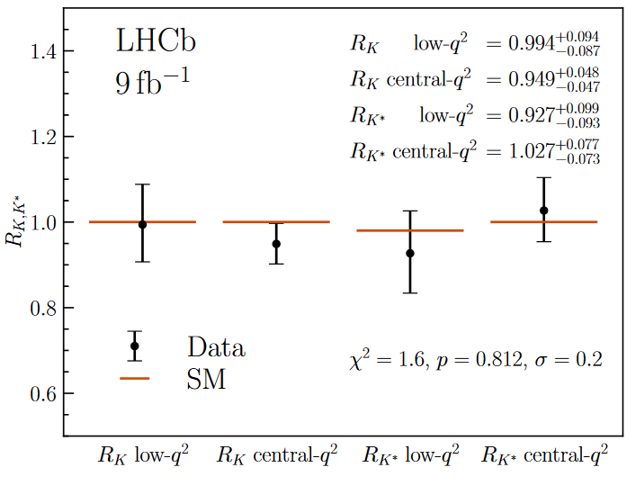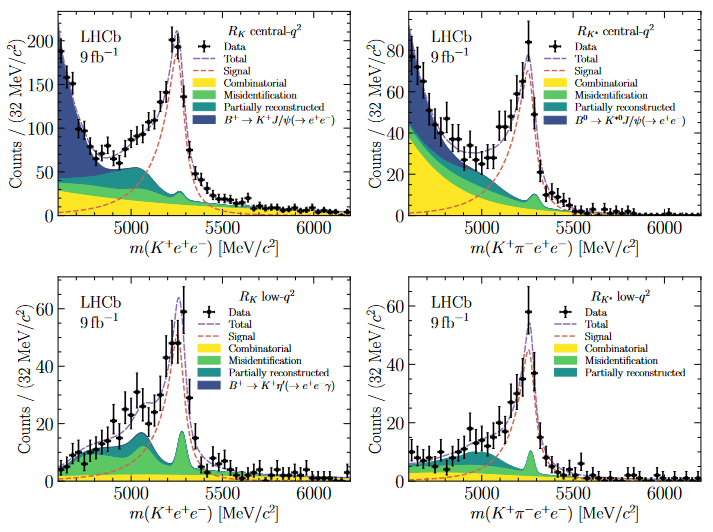

Today at the CERN seminar the LHCb Collaboration presented new tests of lepton universality, one of the basic principles of the Standard Model (SM) of particle physics. This principle states that the SM treats the three charged leptons (electrons, muons and taus) identically, except for differences due to their different masses. The results are in agreement with the SM. The two corresponding papers have been submitted for publication today.
The decays used in this analysis to study lepton universality are extremely rare. They involve the transformation of a beauty quark into a strange quark (b→s), a process that is highly suppressed in the SM and can be affected by the existence of new particles. These undiscovered particles could have masses too high to be produced directly at the Large Hadron Collider.
For these b→s transitions, lepton universality is tested by comparing the ratios of decay rates of beauty particle into different leptons. A significant deviation from these predictions would indicate new physics beyond the SM. The previous results revealed hints of deviations from lepton universality, none of which was statistically significant enough to constitute clear signs of new physics on their own. However, the observed pattern of deviations from the SM predictions might have hinted at the existence of new physics.

Special attention was focused on two ratios, RK and RK*. The ratio RK describes how often a B+ meson decays to a charged kaon and either a pair of oppositely-charged muons (K+μ+μ–) or electrons (K+e+e–). The ratio RK*0 is similar, only the meson K+ is replaced by a K*0 meson in the B meson decay. Previous RK results indicated evidence for the breaking of lepton universality in beauty-quark decays, with a significance of 3.1 standard deviations. Previous RK* measurements, while of smaller statistical sensitivity, exhibited the same coherent pattern of deviations.
The results announced today report a simultaneous measurement of RK and RK* using the full Run1 and Run2 data sample, leading to improved precision on both quantities. The simultaneous analysis allows a coherent approach to experimental effects, including cross-feed between different decays. The analysis is performed in the two q2 intervals 0.1<q2<1.1 GeV2, referred as low-q2, and 1.1<q2<6.0 GeV2, referred as central-q2. The variable q2 is the invariant mass squared of the μ+μ– or e+e– pair.
The image above shows the comparison of RK and RK* measured values with the SM prediction. An overall agreement at the level of 0.2 standard deviations is observed. The numerical values are also indicated in the plot as well as at the top of these news.
The analysis proceeds by comparing the number of beauty particle decays involving muons or electrons and accumulated around the reconstructed beauty particle mass. The peak representing the decay with electrons is wider than the one involving muons, since electrons frequently radiate photons when traversing matter, giving rise to a less precise mass reconstruction and therefore possibly larger background contribution inside the peak mass range. The reconstructed beauty particle mass distributions for decays with electrons are shown in the image below.

Important aspects of the today’s analysis are improvements in the particle identification (PID), particularly in a possible misidentification of hadrons as electrons in the beauty particle decays. The contribution of these backgrounds has been carefully studied and included in the final result – see small green peaks labelled Misidentification.
The results presented here differ from the previous LHCb measurements of RK and RK*, which they supersede. The RK* analysis uses five times more B meson decays than the previous result. For RK central-q2, the difference is partly due to the use of tighter electron identification criteria and partly due to the modeling of the residual misidentified hadronic backgrounds; statistical fluctuations make a smaller contribution to the difference since the same data are used as in the previous publication. It is interesting to note that the statistical uncertainties remain significantly larger than the systematic uncertainties and therefore additional data will continue to challenge the SM.
In addition to the measurements presented today, LHCb performs analyses on lepton flavour universality in the b→clν process and other analyses in b→sll decays. LHCb has studied processes enabling a comparison of decays to muons and tau leptons in b→clν, see R(D)/R(D*), R(J/ψ), and R(Λc+). These decays are particularly interesting since many SM extensions contain new interactions that involve the third generation of quarks and leptons, like a b quark (from a B hadron) and τ+ and ντ leptons in this case. Other analyses of b→sll decays include studies of angular distributions, including the P5’ variable which has been the object of particular attention.
Learn more in the LHCb seminar presentation and in the LHCb papers [1] and [2], as well as in the CERN update and CERN Courier article.
